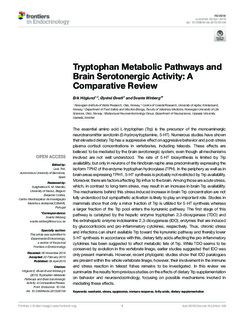| dc.description.abstract | The essential amino acid L-tryptophan (Trp) is the precursor of the monoaminergic neurotransmitter serotonin (5-hydroxytryptamine, 5-HT). Numerous studies have shown that elevated dietary Trp has a suppressive effect on aggressive behavior and post-stress plasma cortisol concentrations in vertebrates, including teleosts. These effects are believed to be mediated by the brain serotonergic system, even though all mechanisms involved are not well understood. The rate of 5-HT biosynthesis is limited by Trp availability, but only in neurons of the hindbrain raphe area predominantly expressing the isoform TPH2 of the enzyme tryptophan hydroxylase (TPH). In the periphery as well as in brain areas expressing TPH1, 5-HT synthesis is probably not restricted by Trp availability. Moreover, there are factors affecting Trp influx to the brain. Among those are acute stress, which, in contrast to long-term stress, may result in an increase in brain Trp availability. The mechanisms behind this stress induced increase in brain Trp concentration are not fully understood but sympathetic activation is likely to play an important role. Studies in mammals show that only a minor fraction of Trp is utilized for 5-HT synthesis whereas a larger fraction of the Trp pool enters the kynurenic pathway. The first stage of this pathway is catalyzed by the hepatic enzyme tryptophan 2,3-dioxygenase (TDO) and the extrahepatic enzyme indoleamine 2,3-dioxygenase (IDO), enzymes that are induced by glucocorticoids and pro-inflammatory cytokines, respectively. Thus, chronic stress and infections can shunt available Trp toward the kynurenic pathway and thereby lower 5-HT synthesis. In accordance with this, dietary fatty acids affecting the pro-inflammatory cytokines has been suggested to affect metabolic fate of Trp. While TDO seems to be conserved by evolution in the vertebrate linage, earlier studies suggested that IDO was only present mammals. However, recent phylogenic studies show that IDO paralogues are present within the whole vertebrate linage, however, their involvement in the immune and stress reaction in teleost fishes remains to be investigated. In this review we summarize the results from previous studies on the effects of dietary Trp supplementation on behavior and neuroendocrinology, focusing on possible mechanisms involved in mediating these effects. | nb_NO |

